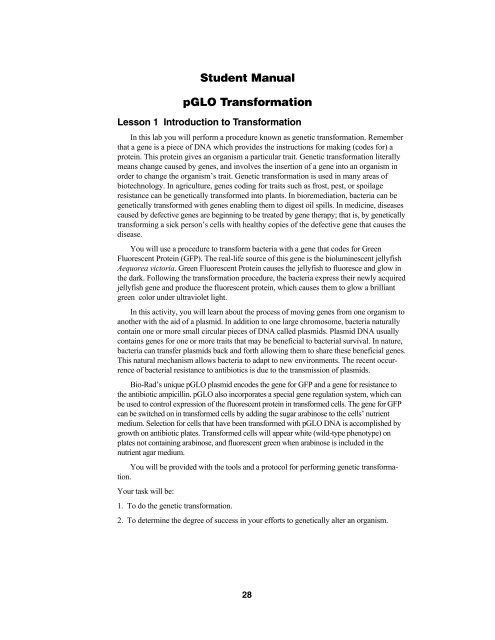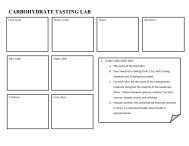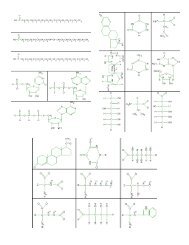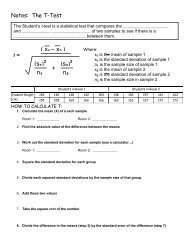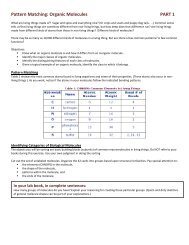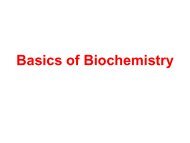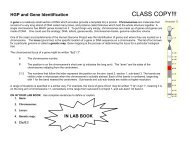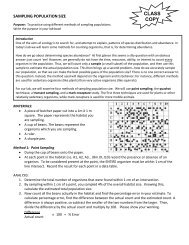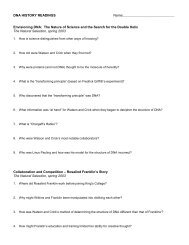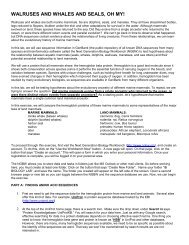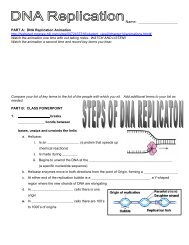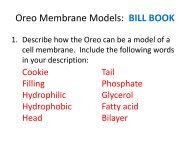Student Manual pGLO Transformation - Biology for Life
Student Manual pGLO Transformation - Biology for Life
Student Manual pGLO Transformation - Biology for Life
Create successful ePaper yourself
Turn your PDF publications into a flip-book with our unique Google optimized e-Paper software.
<strong>Student</strong> <strong>Manual</strong><br />
<strong>pGLO</strong> <strong>Trans<strong>for</strong>mation</strong><br />
Lesson 1 Introduction to <strong>Trans<strong>for</strong>mation</strong><br />
In this lab you will per<strong>for</strong>m a procedure known as genetic trans<strong>for</strong>mation. Remember<br />
that a gene is a piece of DNA which provides the instructions <strong>for</strong> making (codes <strong>for</strong>) a<br />
protein. This protein gives an organism a particular trait. Genetic trans<strong>for</strong>mation literally<br />
means change caused by genes, and involves the insertion of a gene into an organism in<br />
order to change the organism’s trait. Genetic trans<strong>for</strong>mation is used in many areas of<br />
biotechnology. In agriculture, genes coding <strong>for</strong> traits such as frost, pest, or spoilage<br />
resistance can be genetically trans<strong>for</strong>med into plants. In bioremediation, bacteria can be<br />
genetically trans<strong>for</strong>med with genes enabling them to digest oil spills. In medicine, diseases<br />
caused by defective genes are beginning to be treated by gene therapy; that is, by genetically<br />
trans<strong>for</strong>ming a sick person’s cells with healthy copies of the defective gene that causes the<br />
disease.<br />
You will use a procedure to trans<strong>for</strong>m bacteria with a gene that codes <strong>for</strong> Green<br />
Fluorescent Protein (GFP). The real-life source of this gene is the bioluminescent jellyfish<br />
Aequorea victoria. Green Fluorescent Protein causes the jellyfish to fluoresce and glow in<br />
the dark. Following the trans<strong>for</strong>mation procedure, the bacteria express their newly acquired<br />
jellyfish gene and produce the fluorescent protein, which causes them to glow a brilliant<br />
green color under ultraviolet light.<br />
In this activity, you will learn about the process of moving genes from one organism to<br />
another with the aid of a plasmid. In addition to one large chromosome, bacteria naturally<br />
contain one or more small circular pieces of DNA called plasmids. Plasmid DNA usually<br />
contains genes <strong>for</strong> one or more traits that may be beneficial to bacterial survival. In nature,<br />
bacteria can transfer plasmids back and <strong>for</strong>th allowing them to share these beneficial genes.<br />
This natural mechanism allows bacteria to adapt to new environments. The recent occurrence<br />
of bacterial resistance to antibiotics is due to the transmission of plasmids.<br />
Bio-Rad’s unique <strong>pGLO</strong> plasmid encodes the gene <strong>for</strong> GFP and a gene <strong>for</strong> resistance to<br />
the antibiotic ampicillin. <strong>pGLO</strong> also incorporates a special gene regulation system, which can<br />
be used to control expression of the fluorescent protein in trans<strong>for</strong>med cells. The gene <strong>for</strong> GFP<br />
can be switched on in trans<strong>for</strong>med cells by adding the sugar arabinose to the cells’ nutrient<br />
medium. Selection <strong>for</strong> cells that have been trans<strong>for</strong>med with <strong>pGLO</strong> DNA is accomplished by<br />
growth on antibiotic plates. Trans<strong>for</strong>med cells will appear white (wild-type phenotype) on<br />
plates not containing arabinose, and fluorescent green when arabinose is included in the<br />
nutrient agar medium.<br />
You will be provided with the tools and a protocol <strong>for</strong> per<strong>for</strong>ming genetic trans<strong>for</strong>mation.<br />
Your task will be:<br />
1. To do the genetic trans<strong>for</strong>mation.<br />
2. To determine the degree of success in your ef<strong>for</strong>ts to genetically alter an organism.<br />
28
Lesson 1 Focus Questions<br />
There are many considerations that need to be thought through in the process of<br />
planning a scientific laboratory investigation. Below are a few <strong>for</strong> you to ponder as you<br />
take on the challenge of doing a genetic trans<strong>for</strong>mation.<br />
Since scientific laboratory investigations are designed to get in<strong>for</strong>mation about a<br />
question, our first step might be to <strong>for</strong>mulate a question <strong>for</strong> this investigation.<br />
Consideration 1: Can I Genetically Trans<strong>for</strong>m an Organism? Which<br />
Organism?<br />
1. To genetically trans<strong>for</strong>m an entire organism, you must insert the new gene into every<br />
cell in the organism. Which organism is better suited <strong>for</strong> total genetic trans<strong>for</strong>mation—<br />
one composed of many cells, or one composed of a single cell?<br />
2. Scientists often want to know if the genetically trans<strong>for</strong>med organism can pass its new<br />
traits on to its offspring and future generations. To get this in<strong>for</strong>mation, which would be<br />
a better candidate <strong>for</strong> your investigation, an organism in which each new generation<br />
develops and reproduces quickly, or one which does this more slowly?<br />
3. Safety is another important consideration in choosing an experimental organism. What<br />
traits or characteristics should the organism have (or not have) to be sure it will not harm<br />
you or the environment?<br />
4. Based on the above considerations, which would be the best choice <strong>for</strong> a genetic<br />
trans<strong>for</strong>mation: a bacterium, earthworm, fish, or mouse? Describe your reasoning.<br />
29
Consideration 2: How Can I Tell if Cells Have Been Genetically<br />
Trans<strong>for</strong>med?<br />
Recall that the goal of genetic trans<strong>for</strong>mation is to change an organism’s traits<br />
(phenotype). Be<strong>for</strong>e any change in the phenotype of an organism can be detected, a<br />
thorough examination of its natural (pre-trans<strong>for</strong>mation) phenotype must be made.<br />
Look at the colonies of E. coli on your starter plates. List all observable traits or<br />
characteristics that can be described:<br />
The following pre-trans<strong>for</strong>mation observations of E. coli might provide baseline data to<br />
make reference to when attempting to determine if any genetic trans<strong>for</strong>mation has<br />
occurred.<br />
a) Number of colonies<br />
b) Size of : 1) the largest colony<br />
2) the smallest colony<br />
3) the majority of colonies<br />
c) Color of the colonies<br />
d) Distribution of the colonies on the plate<br />
e) Visible appearance when viewed with ultraviolet (UV) light<br />
f) The ability of the cells to live and reproduce in the presence of an antibiotic such as<br />
ampicillin<br />
1. Describe how you could use two LB/agar plates, some E. coli and some ampicillin to<br />
determine how E. coli cells are affected by ampicillin.<br />
2. What would you expect your experimental results to indicate about the effect of<br />
ampicillin on the E. coli cells?<br />
30
Consideration 3: The Genes<br />
Genetic trans<strong>for</strong>mation involves the insertion of some new DNA into the E. coli<br />
cells. In addition to one large chromosome, bacteria often contain one or more small<br />
circular pieces of DNA called plasmids. Plasmid DNA usually contains genes <strong>for</strong> more<br />
than one trait. Scientists can use a process called genetic engineering to insert genes<br />
coding <strong>for</strong> new traits into a plasmid. In this case, the <strong>pGLO</strong> plasmid carries the GFP<br />
gene that codes <strong>for</strong> the green fluorescent protein and a gene (bla) that codes <strong>for</strong> a<br />
protein that gives the bacteria resistance to an antibiotic. The genetically engineered<br />
plasmid can then be used to genetically trans<strong>for</strong>m bacteria to give them this new trait.<br />
Cell<br />
wall<br />
Bacterial<br />
chromosomal<br />
DNA<br />
Consideration 4: The Act of <strong>Trans<strong>for</strong>mation</strong><br />
This trans<strong>for</strong>mation procedure involves three main steps. These steps are intended to<br />
introduce the plasmid DNA into the E. coli cells and provide an environment <strong>for</strong> the cells<br />
to express their newly acquired genes.<br />
To move the <strong>pGLO</strong> plasmid DNA through the cell membrane you will:<br />
1. Use a trans<strong>for</strong>mation solution of CaCl (calcium chloride)<br />
2<br />
2. Carry out a procedure referred to as heat shock<br />
For trans<strong>for</strong>med cells to grow in the presence of ampicillin you must:<br />
3. Provide them with nutrients and a short incubation period to begin expressing their<br />
newly acquired genes<br />
31<br />
Pore<br />
<strong>pGLO</strong> plasmid DNA<br />
GFP<br />
Flagellum<br />
Beta-lactamase<br />
(antibiotic resistance)
Lesson 2 <strong>Trans<strong>for</strong>mation</strong> Laboratory<br />
Workstation Check (✔) List<br />
Your workstation: Materials and supplies that should be present at your workstation prior<br />
to beginning this lab are listed below.<br />
<strong>Student</strong> workstations Number required (✔)<br />
E. coli starter plate 1 ❏<br />
Poured agar plates (1 LB, 2 LB/amp, 1 LB/amp/ara) 4 ❏<br />
<strong>Trans<strong>for</strong>mation</strong> solution 1 ❏<br />
LB nutrient broth 1 ❏<br />
Inoculation loops 7 (1 pk of 10) ❏<br />
Pipets 5 ❏<br />
Foam microtube holder/float 1 ❏<br />
Container full of crushed ice (foam cup) 1 ❏<br />
Marking pen 1 ❏<br />
Copy of Quick Guide 1 ❏<br />
Instructor’s (common) workstation. A list of materials, supplies and equipment that<br />
should be present at a common location to be accessed by your team is also listed below.<br />
Rehydrated <strong>pGLO</strong> plasmid 1 vial ❏<br />
42°C water bath and thermometer<br />
37°C incubator<br />
1 ❏<br />
(optional, see General Laboratory Skills–Incubation) 1 ❏<br />
32
<strong>Trans<strong>for</strong>mation</strong> Procedure<br />
1. Label one closed micro test tube +<strong>pGLO</strong> and another -<strong>pGLO</strong>. Label both tubes with<br />
your group’s name. Place them in the foam tube rack.<br />
+<strong>pGLO</strong><br />
2. Open the tubes and, using a sterile transfer pipet, transfer 250 µl of trans<strong>for</strong>mation<br />
solution (CaCl 2 ) into each tube.<br />
250 µl<br />
<strong>Trans<strong>for</strong>mation</strong> Solution<br />
33<br />
+<strong>pGLO</strong> -<strong>pGLO</strong><br />
-<strong>pGLO</strong>
3. Place the tubes on ice.<br />
4. Use a sterile loop to pick up a single colony of bacteria from your starter plate. Pick up<br />
the +<strong>pGLO</strong> tube and immerse the loop into the trans<strong>for</strong>mation solution at the bottom of<br />
the tube. Spin the loop between your index finger and thumb until the entire colony is<br />
dispersed in the trans<strong>for</strong>mation solution (with no floating chunks). Place the tube back in<br />
the tube rack in the ice. Using a new sterile loop, repeat <strong>for</strong> the -<strong>pGLO</strong> tube.<br />
5. Examine the <strong>pGLO</strong> DNA solution with the UV lamp. Note your observations.<br />
Immerse a new sterile loop into the <strong>pGLO</strong> plasmid DNA stock tube. Withdraw a<br />
loopful. There should be a film of plasmid solution across the ring. This is similar to<br />
seeing a soapy film across a ring <strong>for</strong> blowing soap bubbles. Mix the loopful into the<br />
cell suspension of the +<strong>pGLO</strong> tube. Close the tube and return it to the rack on ice.<br />
Also close the -<strong>pGLO</strong> tube. Do not add plasmid DNA to the -<strong>pGLO</strong> tube. Why not?<br />
34<br />
Ice<br />
+<strong>pGLO</strong><br />
(+<strong>pGLO</strong>)<br />
(-<strong>pGLO</strong>)<br />
<strong>pGLO</strong> Plasmid DNA (+<strong>pGLO</strong>) (-<strong>pGLO</strong>)<br />
+<strong>pGLO</strong>
6. Incubate the tubes on ice <strong>for</strong> 10 minutes. Make sure to push the tubes all the way down<br />
in the rack so the bottom of the tubes stick out and make contact with the ice.<br />
7. While the tubes are sitting on ice, label your four LB nutrient agar plates on the bottom<br />
(not the lid) as follows:<br />
• Label one LB/amp plate: + <strong>pGLO</strong><br />
• Label the LB/amp/ara plate: + <strong>pGLO</strong><br />
• Label the other LB/amp plate: - <strong>pGLO</strong><br />
• Label the LB plate: - <strong>pGLO</strong><br />
<strong>pGLO</strong><br />
L B / a m p<br />
Rack<br />
<strong>pGLO</strong><br />
LB/amp/ara<br />
8. Heat shock. Using the foam rack as a holder, transfer both the (+) <strong>pGLO</strong> and (-)<br />
<strong>pGLO</strong> tubes into the water bath, set at 42oC, <strong>for</strong> exactly 50 seconds. Make sure to<br />
push the tubes all the way down in the rack so the bottom of the tubes stick out and<br />
make contact with the warm water.<br />
When the 50 seconds are done, place both tubes back on ice. For the best trans<strong>for</strong>mation<br />
results, the transfer from the ice (0°C) to 42°C and then back to the ice must be rapid.<br />
Incubate tubes on ice <strong>for</strong> 2 minutes.<br />
35<br />
<strong>pGLO</strong><br />
LB/amp<br />
Water bath<br />
Ice<br />
<strong>pGLO</strong><br />
Ice 42°C <strong>for</strong> 50 seconds Ice<br />
L B
9. Remove the rack containing the tubes from the ice and place on the bench top. Open<br />
a tube and, using a new sterile pipet, add 250 µl of LB nutrient broth to the tube and<br />
reclose it. Repeat with a new sterile pipet <strong>for</strong> the other tube. Incubate the tubes <strong>for</strong><br />
10 minutes at room temperature.<br />
10. Tap the closed tubes with your finger to mix. Using a new sterile pipet <strong>for</strong> each tube,<br />
pipet 100 µl of the trans<strong>for</strong>mation and control suspensions onto the appropriate nutrient<br />
agar plates.<br />
100 µl<br />
+p G<br />
L B / a m p<br />
O L<br />
250 µl<br />
LB broth<br />
+<strong>pGLO</strong><br />
+p G<br />
LB/amp/ara<br />
<strong>Trans<strong>for</strong>mation</strong> plates Control plates<br />
36<br />
- p G<br />
L B / a m p<br />
O L<br />
- p G<br />
L B<br />
O L<br />
O L<br />
+<strong>pGLO</strong><br />
-<strong>pGLO</strong><br />
-<strong>pGLO</strong>
11. Use a new sterile loop <strong>for</strong> each plate. Spread the suspensions evenly around the surface<br />
of the LB nutrient agar by quickly skating the flat surface of a new sterile loop back and<br />
<strong>for</strong>th across the plate surface. DO NOT PRESS TOO DEEP INTO THE AGAR.<br />
+p G<br />
L B / a m p<br />
O L<br />
+p G<br />
LB/amp/ara<br />
O L<br />
12. Stack up your plates and tape them together. Put your group name and class period<br />
on the bottom of the stack and place the stack of plates upside down in the 37°C<br />
incubator until the next day.<br />
37<br />
- p G<br />
L B / a m p<br />
O L<br />
- p G<br />
L B<br />
O L
Lesson 2 Review Questions Name ___________________<br />
Be<strong>for</strong>e collecting data and analyzing your results answer the following questions.<br />
1. On which of the plates would you expect to find bacteria most like the original<br />
non-trans<strong>for</strong>med E. coli colonies you initially observed? Explain your predictions.<br />
2. If there are any genetically trans<strong>for</strong>med bacterial cells, on which plate(s) would they<br />
most likely be located? Explain your predictions.<br />
3. Which plates should be compared to determine if any genetic trans<strong>for</strong>mation has<br />
occurred? Why?<br />
4. What is meant by a control plate? What purpose does a control serve?<br />
38
Control plates <strong>Trans<strong>for</strong>mation</strong> plates<br />
Lesson 3 Data Collection and Analysis<br />
A. Data Collection<br />
Observe the results you obtained from the trans<strong>for</strong>mation lab under normal room lighting.<br />
Then turn out the lights and hold the ultraviolet light over the plates.<br />
1. Carefully observe and draw what you see on each of the four plates. Put your drawings<br />
in the data table in the column on the right. Record your data to allow you to compare<br />
observations of the “+ <strong>pGLO</strong>” cells with your observations <strong>for</strong> the non-trans<strong>for</strong>med<br />
E. coli. Write down the following observations <strong>for</strong> each plate.<br />
2. How much bacterial growth do you see on each plate, relatively speaking?<br />
3. What color are the bacteria?<br />
4. How many bacterial colonies are on each plate (count the spots you see).<br />
+<strong>pGLO</strong><br />
LB/amp<br />
+<strong>pGLO</strong><br />
LB/amp/ara<br />
-<strong>pGLO</strong><br />
LB/amp<br />
-<strong>pGLO</strong><br />
LB<br />
Observations<br />
Observations<br />
39
B. Analysis of Results<br />
The goal of data analysis <strong>for</strong> this investigation is to determine if genetic trans<strong>for</strong>mation<br />
has occurred.<br />
1. Which of the traits that you originally observed <strong>for</strong> E. coli did not seem to become<br />
altered? In the space below list these untrans<strong>for</strong>med traits and how you arrived at this<br />
analysis <strong>for</strong> each trait listed.<br />
Original trait Analysis of observations<br />
2. Of the E. coli traits you originally noted, which seem now to be significantly different<br />
after per<strong>for</strong>ming the trans<strong>for</strong>mation procedure? List those traits below and describe the<br />
changes that you observed.<br />
New trait Observed change<br />
3. If the genetically trans<strong>for</strong>med cells have acquired the ability to live in the presence of the<br />
antibiotic ampicillin, then what might be inferred about the other genes on the plasmid<br />
that you used in your trans<strong>for</strong>mation procedure?<br />
4. From the results that you obtained, how could you prove that the changes that occurred<br />
were due to the procedure that you per<strong>for</strong>med?<br />
40
Lesson 3 Review Questions Name _____________________<br />
What’s Glowing?<br />
If a fluorescent green color is observed in the E. coli colonies then a new question<br />
might well be raised, “What are the two possible sources of fluorescence within the<br />
colonies when exposed to UV light?”<br />
Explain:<br />
1. Recall what you observed when you shined the UV light onto a sample of original<br />
<strong>pGLO</strong> plasmid DNA and describe your observations.<br />
2. Which of the two possible sources of the fluorescence can now be eliminated?<br />
3. What does this observation indicate about the source of the fluorescence?<br />
4. Describe the evidence that indicates whether your attempt at per<strong>for</strong>ming a genetic<br />
trans<strong>for</strong>mation was successful or not successful.<br />
41
Lesson 3 Review Questions Name ____________________<br />
The Interaction between Genes and Environment<br />
Look again at your four plates. Do you observe some E. coli growing on the LB plate that<br />
does not contain ampicillin or arabinose?<br />
1. From your results, can you tell if these bacteria are ampicillin resistant by looking at<br />
them on the LB plate? Explain your answer.<br />
2. How would you change the bacteria’s environment—the plate they are growing on—to<br />
best tell if they are ampicillin resistant?<br />
3. Very often an organism’s traits are caused by a combination of its genes and its environment.<br />
Think about the green color you saw in the genetically trans<strong>for</strong>med bacteria:<br />
a. What two factors must be present in the bacteria’s environment <strong>for</strong> you to see the<br />
green color? (Hint: one factor is in the plate and the other factor is in how you<br />
look at the bacteria).<br />
b. What do you think each of the two environmental factors you listed above are<br />
doing to cause the genetically trans<strong>for</strong>med bacteria to turn green?<br />
c. What advantage would there be <strong>for</strong> an organism to be able to turn on or off particular<br />
genes in response to certain conditions?<br />
42
Lesson 4 Extension Activity: Calculate <strong>Trans<strong>for</strong>mation</strong><br />
Efficiency<br />
Your next task in this investigation will be to learn how to determine the extent to<br />
which you genetically trans<strong>for</strong>med E. coli cells. This quantitative measurement is referred<br />
to as the trans<strong>for</strong>mation efficiency.<br />
In many experiments, it is important to genetically trans<strong>for</strong>m as many cells as possible. For<br />
example, in some types of gene therapy, cells are collected from the patient, trans<strong>for</strong>med in the<br />
laboratory, and then put back into the patient. The more cells that are trans<strong>for</strong>med to produce<br />
the needed protein, the more likely that the therapy will work. The trans<strong>for</strong>mation efficiency is<br />
calculated to help scientists determine how well the trans<strong>for</strong>mation is working.<br />
The Task<br />
You are about to calculate the trans<strong>for</strong>mation efficiency, which gives you an indication<br />
of how effective you were in getting DNA molecules into bacterial cells. <strong>Trans<strong>for</strong>mation</strong><br />
efficiency is a number. It represents the total number of bacterial cells that express the<br />
green protein, divided by the amount of DNA used in the experiment. (It tells us the total<br />
number of bacterial cells trans<strong>for</strong>med by one microgram of DNA.) The trans<strong>for</strong>mation<br />
efficiency is calculated using the following <strong>for</strong>mula:<br />
<strong>Trans<strong>for</strong>mation</strong> efficiency = Total number of cells growing on the agar plate<br />
Amount of DNA spread on the agar plate (in µg)<br />
There<strong>for</strong>e, be<strong>for</strong>e you can calculate the efficiency of your trans<strong>for</strong>mation, you will<br />
need two pieces of in<strong>for</strong>mation:<br />
(1) The total number of green fluorescent colonies growing on your LB/amp/ara<br />
plate.<br />
(2) The total amount of <strong>pGLO</strong> plasmid DNA in the bacterial cells spread on the<br />
LB/amp/ara plate.<br />
43
1. Determining the Total Number of Green Fluorescent Cells<br />
Place your LB/amp/ara plate near a UV light. Each colony on the plate can be assumed to<br />
be derived from a single cell. As individual cells reproduce, more and more cells are<br />
<strong>for</strong>med and develop into what is termed a colony. The most direct way to determine the<br />
total number of green fluorescent cells is to count the colonies on the plate.<br />
Enter that number here ⇒<br />
2. Determining the Amount of <strong>pGLO</strong> DNA in the Bacterial Cells Spread on<br />
the LB/amp/ara Plate<br />
We need two pieces of in<strong>for</strong>mation to find out the amount of <strong>pGLO</strong> DNA in the bacterial<br />
cells spread on the LB/amp/ara plate in this experiment. (a) What was the total amount of<br />
DNA we began the experiment with, and (b) What fraction of the DNA (in the bacteria)<br />
actually got spread onto the LB/amp/ara plates.<br />
Once you calculate this data, you will need to multiply the total amount of <strong>pGLO</strong> DNA<br />
used in this experiment by the fraction of DNA you spread on the LB/amp/ara plate. The<br />
answer to this multiplication will tell you the amount of <strong>pGLO</strong> DNA in the bacterial cells<br />
that were spread on the LB/amp/ara plate.<br />
a. Determining the Total Amount of <strong>pGLO</strong> plasmid DNA<br />
The total amount of DNA we began with is equal to the product of the concentration and<br />
the total volume used, or<br />
(DNA in µg) = (concentration of DNA in µg/µl) x (volume of DNA in µl)<br />
In this experiment you used 10 µl of <strong>pGLO</strong> at concentration of 0.08 µg/µl. This means that<br />
each microliter of solution contained 0.08 µg of <strong>pGLO</strong> DNA. Calculate the total amount<br />
of DNA used in this experiment.<br />
Enter that number here ⇒<br />
How will you use this piece of in<strong>for</strong>mation?<br />
Total number of cells =<br />
_______<br />
44<br />
Total amount of <strong>pGLO</strong> DNA (µg)<br />
used in this experiment =<br />
__________
. Determining the fraction of <strong>pGLO</strong> plasmid DNA (in the bacteria) that actually got<br />
spread onto the LB/amp/ara plate: Since not all the DNA you added to the bacterial cells<br />
will be transferred to the agar plate, you need to find out what fraction of the DNA was actually<br />
spread onto the LB/amp/ara plate. To do this, divide the volume of DNA you spread on the<br />
LB/amp/ara plate by the total volume of liquid in the test tube containing the DNA. A <strong>for</strong>mula<br />
<strong>for</strong> this statement is<br />
Fraction of DNA used = Volume spread on LB/amp plate (µl)<br />
Total sample volume in test tube (µl)<br />
You spread 100 µl of cells containing DNA from a test tube containing a total volume of<br />
510 µl of solution. Do you remember why there is 510 µl total solution? Look in the laboratory<br />
procedure and locate all the steps where you added liquid to the reaction tube. Add the volumes.<br />
Use the above <strong>for</strong>mula to calculate the fraction of <strong>pGLO</strong> plasmid DNA you spread<br />
on the LB/amp/ara plate.<br />
Enter that number here ⇒<br />
• How will you use this piece of in<strong>for</strong>mation?<br />
So, how many micrograms of <strong>pGLO</strong> DNA did you spread on the LB/amp/ara plates?<br />
To answer this question, you will need to multiply the total amount of <strong>pGLO</strong> DNA<br />
used in this experiment by the fraction of <strong>pGLO</strong> DNA you spread on the LB/amp/ara plate.<br />
<strong>pGLO</strong> DNA spread in µg = Total amount of DNA used in µg x fraction of DNA used<br />
• What will this number tell you?<br />
Enter that number here ⇒<br />
45<br />
Fraction of DNA =<br />
________<br />
<strong>pGLO</strong> DNA spread (µg) =<br />
________
Look at all your calculations above. Decide which of the numbers you calculated<br />
belong in the table below. Fill in the following table.<br />
Number of colonies on<br />
LB/amp/ara plate =<br />
Micrograms of <strong>pGLO</strong> DNA<br />
spread on the plates<br />
Now use the data in the table to calculate the efficiency of the <strong>pGLO</strong> trans<strong>for</strong>mation<br />
<strong>Trans<strong>for</strong>mation</strong> efficiency = Total number of cells growing on the agar plate<br />
Amount of DNA spread on the agar plate<br />
Enter that number here ⇒<br />
Analysis<br />
<strong>Trans<strong>for</strong>mation</strong> efficiency calculations result in very large numbers. Scientists often use<br />
a mathematical shorthand referred to as scientific notation. For example, if the calculated<br />
trans<strong>for</strong>mation efficiency is 1,000 bacteria/µg of DNA, they often report this number as:<br />
103 trans<strong>for</strong>mants/µg (103 is another way of saying 10 x 10 x 10 or 1,000)<br />
• How would scientists report 10,000 trans<strong>for</strong>mants/µg in scientific notation?<br />
Carrying this idea a little farther, suppose scientists calculated an efficiency of 5,000<br />
bacteria/µg of DNA. This would be reported as:<br />
5 x 103 trans<strong>for</strong>mants/µg (5 times 1,000)<br />
• How would scientists report 40,000 trans<strong>for</strong>mants/µg in scientific notation?<br />
46<br />
<strong>Trans<strong>for</strong>mation</strong> efficiency =<br />
_____ trans<strong>for</strong>mants/µg
One final example: If 2,600 trans<strong>for</strong>mants/µg were calculated, then the scientific notation<br />
<strong>for</strong> this number would be:<br />
2.6 x 103 trans<strong>for</strong>mants/µg<br />
Similarly:<br />
(2.6 times 1,000)<br />
5,600 = 5.6 x 103 271,000 = 2.71 x 105 2,420,000 = 2.42 x 106 • How would scientists report 960,000 trans<strong>for</strong>mants/µg in scientific notation?<br />
• Report your calculated trans<strong>for</strong>mation efficiency in scientific notation.<br />
• Use a sentence or two to explain what your calculation of trans<strong>for</strong>mation efficiency<br />
means.<br />
Biotechnologists are in general agreement that the trans<strong>for</strong>mation protocol that you<br />
have just completed generally has a trans<strong>for</strong>mation efficiency of between 8.0 x 102 and 7.0<br />
x 103 trans<strong>for</strong>mants per microgram of DNA.<br />
• How does your trans<strong>for</strong>mation efficiency compare with the above?<br />
• In the table below, report the trans<strong>for</strong>mation efficiency of several of the teams in the<br />
class.<br />
Team Efficiency<br />
• How does your trans<strong>for</strong>mation efficiency compare with theirs?<br />
47
• Calculate the trans<strong>for</strong>mation efficiency of the following experiment using the in<strong>for</strong>mation<br />
and the results listed below.<br />
DNA plasmid concentration: 0.08 µg/µl<br />
250 µl CaCl2 trans<strong>for</strong>mation solution<br />
10 µl <strong>pGLO</strong> plasmid solution<br />
250 µl LB broth<br />
100 µl cells spread on agar<br />
227 colonies of trans<strong>for</strong>mants<br />
Fill in the following chart and show your calculations to your teacher:<br />
Number of colonies on LB/amp/ara plate =<br />
Micrograms of DNA spread on the plates =<br />
<strong>Trans<strong>for</strong>mation</strong> efficiency =<br />
• Extra Credit Challenge:<br />
If a particular experiment were known to have a trans<strong>for</strong>mation efficiency of 3 x 103 bacteria/µg of DNA, how many trans<strong>for</strong>mant colonies would be expected to grow on the<br />
LB/amp/ara plate? You can assume that the concentration of DNA and fraction of cells<br />
spread on the LB agar are the same as that of the <strong>pGLO</strong> laboratory.<br />
48
Appendix B Glossary of Terms<br />
Agar Provides a solid matrix to support bacterial growth.<br />
Contains nutrient mixture of carbohydrates, amino<br />
acids, nucleotides, salts, and vitamins.<br />
Antibiotic Selection Use of an antibiotic to select bacteria containing the DNA<br />
of interest. The <strong>pGLO</strong> plasmid DNA contains the gene <strong>for</strong><br />
beta-lactamase that provides resistance to the antibiotic<br />
ampicillin. Once bacteria are trans<strong>for</strong>med with the <strong>pGLO</strong><br />
plasmid, they begin producing and secreting beta-lactamase<br />
protein. Secreted beta-lactamase breaks down ampicillin,<br />
rendering the antibiotic harmless to the bacterial host. Only<br />
bacteria containing the <strong>pGLO</strong> plasmid can grow and <strong>for</strong>m<br />
colonies in nutrient medium containing ampicillin, while<br />
untrans<strong>for</strong>med cells that have not taken up the <strong>pGLO</strong><br />
plasmid cannot grow on the ampicillin selection plates.<br />
Arabinose A carbohydrate isolated from plants that is normally<br />
used as source of food by bacteria.<br />
Beta-Lactamase Beta-lactamase is a protein that provides resistance to<br />
the antibiotic ampicillin. The beta-lactamase protein is<br />
produced and secreted by bacteria that have been<br />
trans<strong>for</strong>med with a plasmid containing the gene <strong>for</strong><br />
beta-lactamase. The secreted beta-lactamase inactivates<br />
the ampicillin present in the LB nutrient agar, which<br />
allows <strong>for</strong> bacterial growth and expression of newly<br />
acquired genes also contained on the plasmid, i.e., GFP.<br />
Biotechnology Applying biology in the real world by the specific<br />
manipulation of living organisms, especially at the<br />
genetic level, to produce potentially beneficial products.<br />
Cloning Cloning is the process of generating virtually endless<br />
copies or clones of an organism or segment of DNA.<br />
Cloning produces a population that has an identical<br />
genetic makeup.<br />
Colony A clump of genetically identical bacterial cells growing<br />
on an agar plate. Because all the cells in a single<br />
colony are genetically identical, they are called clones.<br />
Culture Media The liquid and solid media referred to as LB (named<br />
after Luria and Bertani) broth and agar are made from<br />
an extract of yeast and an enzymatic digest of meat<br />
byproducts which provide a mixture of carbohydrates,<br />
amino acids, nucleotides, salts, and vitamins, all of<br />
which are nutrients <strong>for</strong> bacterial growth. Agar, which is<br />
from seaweed, polymerizes when heated and cooled to<br />
<strong>for</strong>m a solid gel (similar to Jell-O gelatin), and<br />
functions to provide a solid support on which to culture<br />
the bacteria.<br />
53
Genetic Engineering The manipulation of an organism’s genetic material<br />
(DNA) by introducing or eliminating specific genes.<br />
Gene Regulation Gene expression in all organisms is carefully regulated<br />
to allow <strong>for</strong> differing conditions and to prevent wasteful<br />
overproduction of unneeded proteins. The genes<br />
involved in the transport and breakdown of food are<br />
good examples of highly regulated genes. For example,<br />
the simple sugar, arabinose, can be used as a source of<br />
energy and carbon by bacteria. The bacterial enzymes<br />
that are needed to break down or digest arabinose <strong>for</strong><br />
food are not expressed in the absence of arabinose but<br />
are expressed when arabinose is present in the<br />
environment. In other words when arabinose is<br />
around, the genes <strong>for</strong> these digestive enzymes are<br />
turned on. When arabinose runs out these genes are<br />
turned back off. See Appendix D <strong>for</strong> a more detailed<br />
explanation of the role that arabinose plays in the<br />
regulation and expression of the Green Fluorescent<br />
Protein gene.<br />
Green Fluorescent Protein Green Fluorescent Protein (GFP) was originally isolated<br />
from the bioluminescent jellyfish, Aequorea victoria.<br />
The gene <strong>for</strong> GFP has recently been cloned. The<br />
unique three-dimensional con<strong>for</strong>mation of GFP causes<br />
it to resonate when exposed to ultraviolet light and give<br />
off energy in the <strong>for</strong>m of visible green light.<br />
Plasmid A circular DNA molecule, capable of self-replicating,<br />
carrying one or more genes <strong>for</strong> antibiotic resistance<br />
proteins and a cloned <strong>for</strong>eign gene such as GFP.<br />
<strong>pGLO</strong> Plasmid containing the GFP sequence and ampicillin<br />
resistance gene, which codes <strong>for</strong> beta-lactamase.<br />
Recombinant DNA Technology The process of cutting and recombining DNA fragments<br />
as a means to isolate genes or to alter their structure<br />
and function.<br />
Screening Process of identifying wanted bacteria from a bacterial<br />
library.<br />
Sterile Technique Minimizing the possibility of outside bacterial<br />
contamination during an experiment through<br />
observance of cleanliness and using careful laboratory<br />
techniques.<br />
Streaking Process of passing an inoculating loop with bacteria<br />
on it across an agar plate<br />
Vector An autonomously replicating DNA molecule, such as<br />
a plasmid, into which <strong>for</strong>eign DNA fragments are<br />
inserted and then propagated in a host cell.<br />
54
Appendix D Gene Regulation<br />
Our bodies contain thousands of different proteins which per<strong>for</strong>m many different jobs.<br />
Digestive enzymes are proteins; some of the hormone signals that run through our bodies<br />
and the antibodies protecting us from disease are proteins. The in<strong>for</strong>mation <strong>for</strong> assembling<br />
a protein is carried in our DNA. The section of DNA which contains the code <strong>for</strong> making a<br />
protein is called a gene. There are over 30,000–100,000 genes in the human genome. Each<br />
gene codes <strong>for</strong> a unique protein: one gene, one protein. The gene that codes <strong>for</strong> a digestive<br />
enzyme in your mouth is different from one that codes <strong>for</strong> an antibody or the pigment that<br />
colors your eyes.<br />
Organisms regulate expression of their genes and ultimately the amounts and kinds of<br />
proteins present within their cells <strong>for</strong> a myriad of reasons, including developmental changes,<br />
cellular specialization, and adaptation to the environment. Gene regulation not only allows <strong>for</strong><br />
adaptation to differing conditions, but also prevents wasteful overproduction of unneeded<br />
proteins which would put the organism at a competitive disadvantage. The genes involved in<br />
the transport and breakdown (catabolism) of food are good examples of highly regulated<br />
genes. For example, the sugar arabinose is both a source of energy and a source of carbon. E.<br />
coli bacteria produce three enzymes (proteins) needed to digest arabinose as a food source.<br />
The genes which code <strong>for</strong> these enzymes are not expressed when arabinose is absent, but they<br />
are expressed when arabinose is present in their environment. How is this so?<br />
Regulation of the expression of proteins often occurs at the level of transcription from<br />
DNA into RNA. This regulation takes place at a very specific location on the DNA template,<br />
called a promoter, where RNA polymerase sits down on the DNA and begins transcription of<br />
the gene. In bacteria, groups of related genes are often clustered together and transcribed into<br />
RNA from one promoter. These clusters of genes controlled by a single promoter are called<br />
operons.<br />
The three genes (araB, araA and araD) that code <strong>for</strong> three digestive enzymes involved in<br />
the breakdown of arabinose are clustered together in what is known as the arabinose operon. 3<br />
These three proteins are dependent on initiation of transcription from a single promoter, PBAD .<br />
Transcription of these three genes requires the simultaneous presence of the DNA template<br />
(promoter and operon), RNA polymerase, a DNA binding protein called araC and arabinose.<br />
araC binds to the DNA at the binding site <strong>for</strong> the RNA polymerase (the beginning of the<br />
arabinose operon). When arabinose is present in the environment, bacteria take it up. Once<br />
inside, the arabinose interacts directly with araC which is bound to the DNA. The interaction<br />
causes araC to change its shape which in turn promotes (actually helps) the binding of RNA<br />
polymerase and the three genes araB, A and D, are transcribed. Three enzymes are produced,<br />
they break down arabinose, and eventually the arabinose runs out. In the absence of arabinose<br />
the araC returns to its original shape and transcription is shut off.<br />
The DNA code of the <strong>pGLO</strong> plasmid has been engineered to incorporate aspects of the<br />
arabinose operon. Both the promoter (P ) and the araC gene are present. However, the<br />
BAD<br />
genes which code <strong>for</strong> arabinose catabolism, araB, A and D, have been replaced by the single<br />
gene which codes <strong>for</strong> GFP. There<strong>for</strong>e, in the presence of arabinose, araC protein promotes<br />
the binding of RNA polymerase and GFP is produced. Cells fluoresce brilliant green as they<br />
produce more and more GFP. In the absence of arabinose, araC no longer facilitates the<br />
binding of RNA polymerase and the GFP gene is not transcribed. When GFP is not made,<br />
bacteria colonies will appear to have a wild-type (natural) phenotype—of white colonies<br />
with no fluorescence.<br />
This is an excellent example of the central molecular framework of biology in action:<br />
DNA→RNA→PROTEIN→TRAIT.<br />
60
araC<br />
The Arabinose Operon<br />
araC<br />
araC<br />
araC<br />
RNA Pol<br />
P BAD<br />
P BAD<br />
araB<br />
arabinose<br />
araB<br />
RNA Pol<br />
Expression of Green Fluorescent Protein<br />
araC<br />
araC<br />
araC<br />
araC<br />
RNA Pol<br />
P BAD<br />
61<br />
araA araD<br />
araA araD<br />
araB araA araD<br />
araB<br />
m RNA<br />
RNA Pol<br />
GFP<br />
arabinose<br />
GFP<br />
RNA Pol<br />
GFP<br />
GFP<br />
m RNA<br />
RNA Pol<br />
araD
Appendix E References<br />
1. Hanahan, Douglas, Studies on trans<strong>for</strong>mation of Escherichia coli with plasmids. J. Mol. Biol., 166,<br />
557 (1983).<br />
2. Hanahan, Douglas, Techniques <strong>for</strong> trans<strong>for</strong>mation of E. coli. In DNA Cloning: A Practical Approach<br />
(Ed. D. M. Glover), vol. 1. IRL Press, Ox<strong>for</strong>d (1987).<br />
3. Schleif, Robert,Two positively regulated systems, ara and mal, In Escherichia coli and Salmonella,<br />
Cellular and Molecular <strong>Biology</strong>, Neidhardt. ASM Press, Washington, D.C. (1996).<br />
Parafilm is a trademark of American National Can Co.<br />
Jell-O is a trademark of Kraft Foods, Inc.<br />
62


